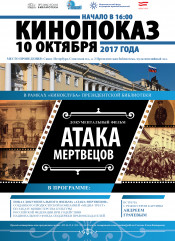
The Presidential Library screens a movie about the little-known feat of the Russian soldiers during the First World War
Next in turn meeting of the Presidential Library Cinema Club scheduled a screening and discussion of a movie by Andrei Grachev “Onslaught of the Dead. A Legend of the Osowiec Fortress” will take place in the library on October 10, 2017, at 4 pm. The movie is courtesy of the National Endowment for Copyright.
The movie is dedicated to one of the most striking and yet little-known exploits of Russian soldiers during the First World War. A small Russian garrison had to survive only 48 hours, instead — it acted on the defensive for more than six months — 190 days!
Located 50 kilometers from the town of Bialystok, now owned by Poland, Osowiec Fortress was founded in 1795, after accession of Polish territories into the Russian Empire. The construction of various fortifications in the fortress itself and around it was conducted for more than a hundred years. The first military operations in the history of the Osowiec began in September 1914, when military units of the 8th German Army approached to it.
The Germans had a multiple numerical superiority, were able to pull with them heavy artillery, but the assault was repulsed.
On February 3, 1915, the second assault on the fortress Osowiec began. In just one week of besiegement of the fortress, about 250,000 shells of large caliber were fired. The Russians stood to death. Without relying more on the power of the siege-guns, the German command decided to use the chemical warfare agents, the first use of which took place on the Western Front on the Ieper River in April 1915.
30 gas-cylinder batteries were deployed in the German positions near Osowiec, which at 4 am on August 6, 1915, after waiting till a fair wind, began to bleed chlorine. Gas eventually penetrated to a total depth of 20 km, while retaining lethality to a depth of up to 12 km and up to 12 meters in height. Russian troops did not have any effective means of protecting against gas at the time. As a result, the 226th Zemlyansk Regiment, which held the defenses in the direction of the main attack, suffered heavy losses.
Following the gas attack, German artillery began to fire, followed by the German infantry, in which up to 7,000 people participated.
The commandant of the fortress gave the order to counterattack the enemy with bayonets and “with anything that can be used.” The commander of the 13th company of the Zemlyansk Regiment Lieutenant Vladimir Kotlinsky led the counterattack. Together with the remnants of his company, he led the survived gas attack, the least affected by the chlorine fighters.
It was a horrible sight: people with chemical burns on their earth-colored faces, wound with rags (the only Russian back then means of protection against gas), and instead shouting “hurray” making terrible, inhuman wheezing, were walking into the bayonet attack.
Several dozen dying Russian soldiers fled the German infantry. By 11 o'clock it became clear that the assault had been repulsed.
The meeting of the Cinema Club will take place in the multimedia hall of the Presidential Library at the address: 3 Senatskaya Square, St. Petersburg, RF 190000.
Please confirm your presence over phone +7 (812) 305 1635,
+ 7 921 594 1613 or emailing Elena Viktorovna Smolina at smolina@prlib.ru.
An accreditation of media representatives will last until 3 pm on October 9, 2017.
Please, submit your applications for accreditation in the attached form with the “Media accreditation” note in subject line to Natalia Korkonosenko korkonosenko@prlib.ru, Press Service of the Presidential Library, phone +7 (812) 305 1621 (ext. 265), mobile: +7 (921) 427 8648.
Your application on the attached form must specify a media name, a full name of media representative, a date and a place of the representative’s birth, full passport or picture id details (series, number, when and by what body it was issued, place of residence), a carry-on equipment (including notebooks and tablet computers), and the contact phone numbers.
Please be advised, that the event participants and guests enter the Presidential Library through the entrance № 1, and the media representatives — through the entrance № 2 by appointment only and without any exceptions upon presentment of passport or picture id.

